Use of Renewable Energy Sources in Students Home
– a Green initiative
Use of Renewable Energy Sources in Students Home
– a Green initiative
Students Home implements the below major initiatives in its premises to generate and use renewable energy to meet its energy needs and also recycle the energy resources for better use.
Use of Rooftop Photovoltaic solar panels with net metering facility for electricity generation
Solar photovoltaic plants are installed on the terraces of many buildings in the Home. Total capacity of the solar PV plants is 145kW. These plants are connected to state power grid through Bi-directional energy meters so that excess electricity produced during the day after meeting our usage can be exported to state grid and in the nights electricity can be imported from the grid. Home has to pay for the net difference of electricity units between imported units from grid and exported units to grid. This arrangement is called Net Metering and reduces the electricity bills substantially.
There is no use of batteries to store electricity. Hence the cost of electricity produced is very low and we minimize the ill effects of batteries on environment. Latest addition of 25kW solar PV plant is installed on a dual axis tracking system which increases the efficiency of the solar plant by 35-40%.
The Students Home meets 80-85% of its electricity needs from the Solar PV plants in a year. Polytechnic college students maintain the solar plants. Every day they clean the panels, monitor the electricity generation and collect data on generation, usage, export and import of electricity to state grid.


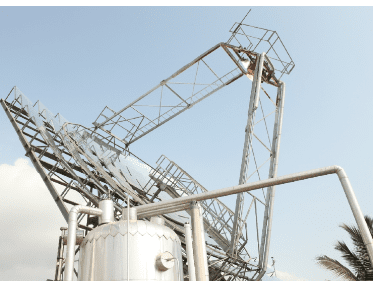
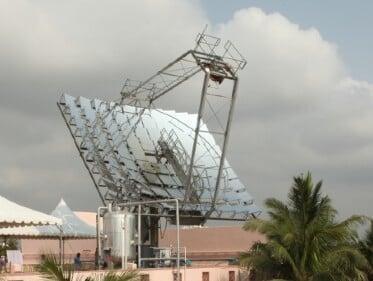
Producing steam to cook food for students through solar steam cooking system
Arun100 – a concentrated solar thermal technology (CST) based dish is used to produce heat from sunlight. This heat is focused on a solar boiler with cold water and converts the cold water into steam. Steam is stored in an insulated accumulator and used in the kitchen to cook rice, dal, vegetables, idlies and boil milk and others. Steam accumulator helps to store steam for cooking during non-solar hours – nights and early mornings.
Solar grade mirrors (area 90sqm) are fixed on a rectangular frame in Fresnel lens formation focusing sunlight towards a solar boiler where cold water is stored. This whole dish setup is moved automatically focusing towards the sun by automatic dual axis tracking mechanism. The dish will move east to west and north to south to track the sun. This movement is just like a sunflower following the sun through the day! This tracking increases the efficiency of the system.
Sun light which falls on the mirrors is focused on the solar boiler and the resultant heat converts the water stored in the boiler as steam and sent to the accumulator for storage. Sensors in the boiler enable pumps to supply water to the boiler automatically.
The solar steam plant can produce 550 kgs of steam on a clear sunny day. 165 kgs of steam can be stored in the accumulator for next day morning use. In the Students Home we are able to cook breakfast, lunch, evening tiffin and night dinner with the help of steam produced by the solar steam plant. This system is working as alternate source of steam for existing LPG fired steam boiler which supply steam during cloudy and rainy days.
By this plant 25-30kgs of LPG can be saved per day. Started in Oct 2013, the solar steam plant is working continuously to supply steam which is produced by solar energy, for our energy needs in the kitchen.
Using solar water heaters for hot water supply to kitchen and living rooms
Solar water heaters are used in the Students Home to supply hot water to the kitchen for cooking. For boiling rice, dhall, vegetables etc we use the hot water at 70 to 75 degree C from solar water heater instead of cold water at room temperature. This helps us to reduce the cooking time and energy to cook. At present we have installed solar water heaters with 750 liters per day capacity.
The process produces a renewable energy source like methane. The byproduct produced during the process is a solid residue which is high-grade manure. Biogas is used for cooking in a specially designed burner. In the Students Home the Bio Gas plant was installed on a trial basis and upgrading the plant is under consideration.
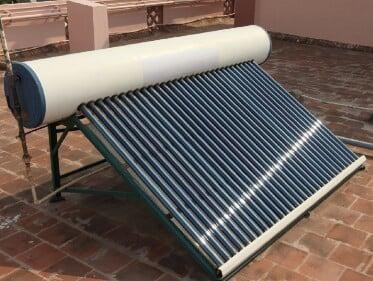
Recognition for our Green Initiatives
Ramakrishna Mission Students’ Home was awarded first and the prestigious Platinum rated Green School in Tamilnadu & became the fourth school to be awarded with platinum rating in India in 2015 by The Indian Green Building Council (IGBC), part of the Confederation of Indian Industry (CII), for our Eco-Friendly Green Campus Initiatives and is continuously monitoring and maintaining sustainable water practices, Conserving and harvesting energy, Health and Hygiene etc.
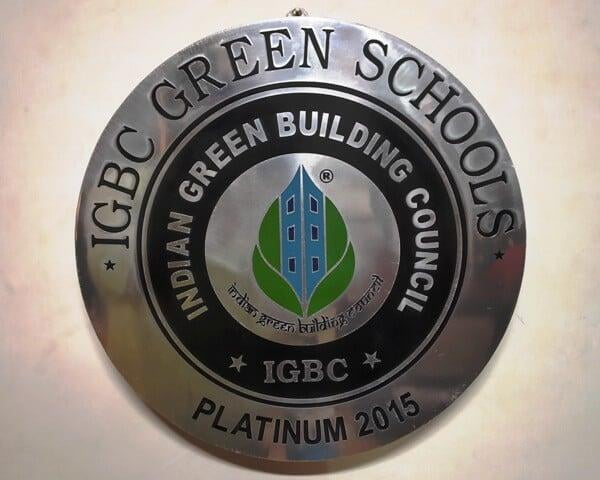
"A green building is one which uses less water, optimizes energy efficiency, conserves natural resources, generates less waste and provides healthier spaces for occupants, as compared to a conventional building."
Construction of rain water harvesting wells and a sump
Over-exploitation of ground water has resulted in the sharp depletion of the groundwater table and to deterioration of its quality as well. In Chennai's coastal suburbs in particular, seawater has already intruded into the coastal aquifers, rendering groundwater quite saline.
We collect and store rainwater into wells dug at low level areas throughout our campus. Sides of the circular wells are strengthened with circular concrete rings with a perforated concrete lid on top of the well. Rain water is collected in these wells during rain and percolates into the soil. Because of this ground water levels are maintained.
Water ducts with perforated concrete covers had been constructed around the playground to help rain water seepage through the soil.
A sump with a capacity of one lakh liters of storage is built to collect rain water for Home’s use. Rain water from rooftops of two buildings are filtered and collected in the sump for later use.
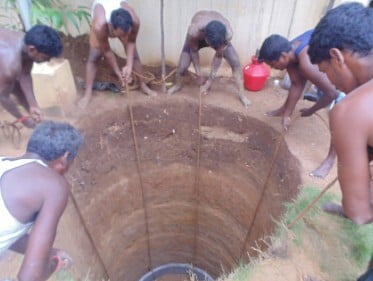
Recycling waste water from kitchen, dining halls, and bathing halls to water the plants
A Waste Water Recycling Plant was installed in 2006 designed to process 20000 liters per day (LPD) waste water with the support, design and installation help from Central Leather and Research Institute, Chennai (CLRI). Waste water is collected from kitchen, dining halls and bathing halls. Treated water is used for watering the plants inside our campus.
The present strength of our inmates is almost doubled and the usage of water is around 60000 LPD. To treat the excess water the Waste Water Recycling Plant is upgraded to process 60000 liters per day (LPD) with the addition of FICCO reactor and other upgradations.
We expect full utilization of waste water after treatment will add to water conservation. The upgraded plant will help in - very low COD (Chemical Oxygen Demand), efficient treatment of water, reduction in sludge generation, foaming and odor and others.

